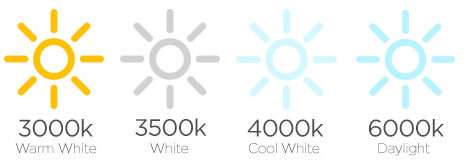Look inside any kitchen, bedroom, hallway or living room, and it’s highly likely that you’ll be presented with at least one – if not a cluster – of tiny spotlights nestled neatly in the ceiling.
LED spotlights have enjoyed a monumental surge in popularity in recent years, and with good reason. They’re modern, easy to replace and above all, versatile.
The key to an LED spotlight’s versatility lies in its colour and beam angle. Wider beam angles and warmer colours are great for ambient lighting, where the light is dispersed over a wider area. Cooler colours and narrower angles are ideal for highlighting specific fixtures or areas of a room, which is particularly useful in commercial or public settings.
What are LED spotlights?
Since its rise to prominence, LED technology has rapidly permeated almost every rung of the lighting industry, and LED alternatives to nearly every light bulb design are now widely available. Spotlights are no exception.
Put simply, LED spotlights look and work in exactly the same way as your old halogen or incandescent spotlights, but use modern LED technology as their primary light source. This carries with it a whole slew of benefits, from reduced running and replacement costs to withered energy bills and the rewarding feeling of contributing to a cleaner planet.
Why should I switch to LED Spotlights?
To many, the main barrier to switching to LED light bulbs is both a lack of information and the false impression that LED is more expensive and ultimately inferior to older technologies.
This may have been true a several years ago, but today LED light bulbs successfully mimic the warm glow and brightness of your older filament light bulbs flawlessly while also shaving up to 90% off your lighting bill.
Despite a moderately higher initial cost, LED spotlights can pay for themselves by way of reduced energy costs within a year or less, so when you consider that LED light bulbs are designed to last 20-50x longer than traditional incandescent lamps, the potential savings associated with them can be massive.
As a general rule, LED light bulbs use around 10% of the energy of incandescent light bulbs, as indicated by their equivalent wattages.
What is Colour Temperature, and why does it matter?
An incandescent light bulb’s warm glow is dictated entirely by its technology. Incandescent – as the name implies – work by forcing heat through a metal (normally tungsten) filament that then heats up and glows. This consequently generates light, while also lending the light bulb its unmistakable warm colour. Even though halogen light bulbs work differently, they also possess a similarly warm glow.
However, one of the many virtues of LED is that it can recreate a whole host of colours, from the warm white of traditional light bulbs to brighter, whiter, modern equivalents and beyond.
As you can see in the diagram above, the colour temperature is measured in Kelvin, with the relevant value denoted by a number, followed by a ‘k’. The lower the number, the ‘warmer’ temperature, simple.
To successfully mimic the glow of an incandescent filament light bulb, it’s best to go for a warm white light bulb that sits between 2700k and 3000k. This works especially well in homely, traditional environments where cosiness is key. The ‘cooler’ temperatures look whiter and most often used in places such as kitchens and bathrooms where a clean white or cool white light is preferred. The daylight bluer options are most often found in retail environments, public areas and workplaces where natural light may otherwise be restricted.
Can I dim my LED spotlights?
Of course! Dimming LED light bulbs is not as straightforward as dimming any incandescent or halogen light bulb. LED technology requires a different set of circumstances to dim correctly. For a full explanation of what this involves, from how to calculate load levels to which type of dimmer switch to use, please see our extensive dimming guide.
I’m switching to LED light bulbs: do I need to rewire my fitting?
So, you’ve decided to make the switch to LED spotlights. Congratulations!
So, what happens now? Do you need to rewire your fittings or hire an electrician?
This would depend entirely on which kind of spotlights you currently have, and what you want to replace them with.
GU10 spotlight bulbs are a mains voltage spotlight and therefore much easier to replace; simply remove your old light bulb and replace it with an LED equivalent. Comparing the equivalent wattages or lumen values of both light bulbs will ensure that the newly installed LED looks the same as the old light bulb in terms of its brightness and quality.
Aside from this, there really is nothing else to worry about when replacing a GU10 spotlight bulb. Simply remove the old one, twist the LED into the fitting, lock it into place and then stand back and marvel as your lighting bill begins to plummet.
MR16 light bulbs aren’t quite as straightforward. As a low voltage light bulb, these require a transformer to step down the mains voltage to a more comfortable 12V that the light bulb can deal with. If you’re replacing halogen MR16 spotlights with LED equivalents, you’ll probably also need to purchase a modern, electronic LED driver that is designed to deal with the lower wattages of LED.
An old-school magnetic transformer will work just fine with LED light bulbs, but transformers are similar to dimmer systems in that they normally have a predetermined wattage range that they expect their light bulb(s) to sit within. Replacing your MR16 light bulbs with LED equivalents is going to obliterate your cumulative wattage (which is a good thing) but it does also mean that you’re probably going to drop below your transformer’s minimum wattage requirements. This can result in flickering light bulbs, strobing or outright failure of the circuit.
Purchasing an electronic driver is the best way to avoid this. However, this in itself poses its own set of unique issues from ensuring that the driver itself is LED ready (some were designed before the days of LED and therefore don’t play ball too well) to then making sure that it delivers the correct current and voltage (normally 12V Direct Current in the case of LED MR16 spotlight bulbs).
Ultimately with the extra effort involved, we would normally advise simply returning your circuit to mains voltage and using GU10s instead. This obviates the need for a transformer completely and eradicates any potential compatibility issues. Think of it as cutting out the middleman and giving yourself a nice, clean circuit with no unnecessary tinkering going on in the background. However, if you do find yourself in a situation where MR16 spotlight bulbs are the only option, a full range of LED drivers can be found on Lightbulbs Direct.
The advent of LED has brought with it a tranche of new benefits. The fact that you can still revel in a spotlight’s sexy aesthetics while also cutting your lighting bill by up 90% sounds almost too good to be true, but I can assure you it’s not.
LED spotlights may be relatively new, but they’re certainly not new-fangled; so go on, tuck in, because having your cake and eating it has never tasted so good.






That’s a wonderful guide you have provided here. Good quality lights and brightness are needed whether it is about your house, office or any other place. Thanks. The above guide is helpful.